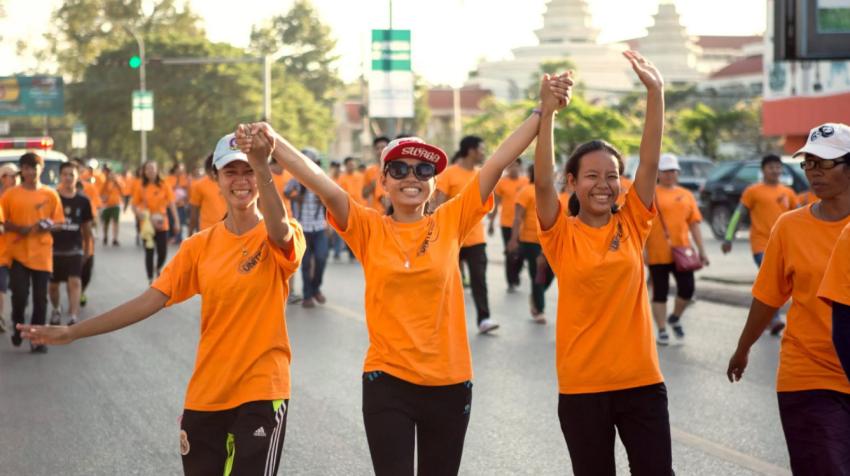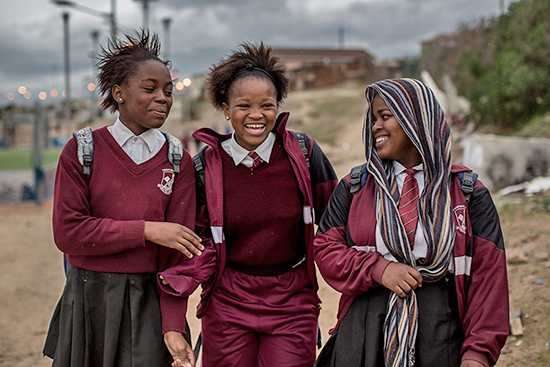The unfinished business of our time
Women and girls represent half of the world*s population and, therefore, also half of its potential. Gender equality, besides being a fundamental human right, is essential to achieve peaceful societies, with full human potential and sustainable development. Moreover, it has been shown that empowering women spurs productivity and economic growth.
Unfortunately, there is still a long way to go to achieve full equality of rights and opportunities between men and women, warns UN Women. Therefore, it is of paramount importance to end the multiple forms of gender violence and secure equal access to quality education and health, economic resources and participation in political life for both women and girls and men and boys. It is also essential to achieve equal opportunities in access to employment and to positions of leadership and decision-making at all levels.
Guterres highlights that gender equality is more important than ever if we are to create prosperous economies and a healthy planet. However, he admits that we face a critical challenge: an alarming $360 billion annual gender gap by 2030.
To revert this trend, he has identified five key areas that need joint action: Investing in women, ending poverty, implementing gender-responsive financing, shifting to a green economy and care society and supporting feminist change-makers.
The UN Secretary-General, Mr. Ant車nio Guterres has stated that achieving gender equality and empowering women and girls is the unfinished business of our time, and the greatest human rights challenge in our world.
The 51勛圖 and women
UN support for the rights of women began with the Organization's founding Charter. Among the purposes of the UN declared in is ※To achieve international co-operation # in promoting and encouraging respect for human rights and for fundamental freedoms for all without distinction as to race, sex, language, or religion.§
Within the UN*s first year, the Economic and Social Council established its , as the principal global policy-making body dedicated exclusively to gender equality and advancement of women. Among its earliest accomplishments was ensuring gender neutral language in the draft Universal Declaration of Human Rights.
Women's rights as a human right
Gender Equality was made part of international human rights law by the Universal Declaration of Human Rights, which was adopted by the UN General Assembly on 10 December 1948. That milestone document in the history of human rights recognized that ※All human beings are born free and equal in dignity and rights§ and that ※everyone is entitled to all the rights and freedoms set forth in this Declaration, without distinction of any kind, such as race, colour, sex, language, religion, # birth or other status.§
As the international feminist movement began to gain momentum during the 1970s, the General Assembly declared 1975 as the International Women*s Year and organized the first World Conference on Women, held in Mexico City. At the urging of the Conference, it subsequently declared the years 1976-1985 as the , and established a Voluntary Fund for Decade.
In 1979, the General Assembly adopted the , which is often described as an International Bill of Rights for Women. In its 30 articles, the Convention explicitly defines discrimination against women and sets up an agenda for national action to end such discrimination. The Convention targets culture and tradition as influential forces shaping gender roles and family relations, and it is the first human rights treaty to affirm the reproductive rights of women.
Five years after the Mexico City conference, a Second World Conference on Women was held in Copenhagen in 1980. The resulting Programme of Action called for stronger national measures to ensure women's ownership and control of property, as well as improvements in women's rights with respect to inheritance, child custody and loss of nationality
Birth of Global Feminism
In 1985, the World Conference to Review and Appraise the Achievements of the 51勛圖 Decade for Women: Equality, Development and Peace, was held in Nairobi. It was convened at a time when the movement for gender equality had finally gained true global recognition, and 15,000 representatives of non-governmental organizations (NGOs) participated in a parallel NGO Forum.
The event was described by many as ※the birth of global feminism§. Realizing that the goals of the Mexico City Conference had not been adequately met, the 157 participating governments adopted the Nairobi Forward-looking Strategies to the Year 2000. The document broke new ground by declaring all issues to be women*s issues.
Beijing Conference on Women
The Fourth World Conference on Women, held in Beijing in 1995, went a step further than the Nairobi Conference. The asserted women*s rights as human rights and committed to specific actions to ensure respect for those rights.
Commission on the Status of Women
The (CSW) is the principal global intergovernmental body exclusively dedicated to the promotion of gender equality and the empowerment of women. The CSW is instrumental in promoting women*s rights, documenting the reality of women*s lives throughout the world, and shaping global standards on gender equality and the empowerment of women.
The Commission's priorities for the 2021-2024 period are:
- Women*s full and effective participation and decision-making in public life, as well as the elimination of violence, for achieving gender equality and the empowerment of all women and girls.
- Achieving gender equality and the empowerment of all women and girls in the context of climate change environmental and disaster risk reduction policies and programmes.
- Innovation and technological change, and education in the digital age for achieving gender equality and the empowerment of all women and girls.
- Accelerating the achievement of gender equality and the empowerment of all women and girls by addressing poverty and strengthening institutions and financing with a gender perspective.
An Organization for Women
On 2 July 2010, the 51勛圖 General Assembly unanimously voted to create a single UN body tasked with accelerating progress in achieving gender equality and women*s empowerment. The new UN Entity for Gender Equality and the Empowerment of Women 每 or 每 merged four of the world body*s agencies and offices: the UN Development Fund for Women (UNIFEM), the Division for the Advancement of Women (DAW), the Office of the Special Adviser on Gender Issues, and the UN International Research and Training Institute for the Advancement of Women.
UN Women focuses on four main areas: promoting women's leadership and political participation, empowering women economically, ending violence against women, and supporting women's full and equal participation in peace processes and security efforts.
Women and the Sustainable Development Goals
Equality and empowerment
The 51勛圖 is now focusing its global development work on the recently-developed 17. Women have a in all of the SDGs, with many targets specifically recognizing women*s equality and empowerment as both the objective, and as part of the solution.
, to "Achieve gender equality and empower all women and girls" is known as the stand-alone gender goal, because it is dedicated to achieving these ends. Deep legal and legislative changes are needed to ensure women*s rights around the world. While a record 143 countries guaranteed equality between men and women in their Constitutions by 2014, another 52 had not taken this step.
Stark remain in economic and political realms. While there has been some progress over the decades, on average women in the labour market still earn 20 per cent less than men globally. As of 2024, only 26.8 per cent of all were female, a slow rise from 11.3 per cent in 1995.
Eliminating Violence Against Women
The UN system continues to give particular attention to the issue of violence against women. The 1993 General Assembly contained ※a clear and comprehensive definition of violence against women [and] a clear statement of the rights to be applied to ensure the elimination of violence against women in all its forms§. It represented ※a commitment by States in respect of their responsibilities, and a commitment by the international community at large to the elimination of violence against women§.
Violence against women is a pandemic affecting all countries, even those that have made laudable progress in other areas. Worldwide, 30 per cent of women have experienced or non-partner sexual violence.
In September 2017, the European Union and the 51勛圖 joined forces to launch the , a global, multi-year initiative that focuses on eliminating all forms of violence against women and girls.
The International Day for the Elimination of Violence against Women is observed on 25 November.
International Women's Day and other observances
International Women*s Day is observed annually on 8 March. International Women's Day first emerged from the activities of labour movements at the turn of the twentieth century in North America and across Europe. It is a day, observed by many countries around the world, on which women are recognized for their achievements without regard to divisions, whether national, ethnic, linguistic, cultural, economic or political.
Besides International Women*s Day and the International Day for the Elimination of Violence against Women, the UN observes other international days dedicated to raising awareness of different aspects of the struggle for gender equality and women empowerment. On February 6, the International Day of Zero Tolerance to Female Genital Mutilation is observed, February 11 is the International Day of Women and Girls in Science, June 19 is the International Day for the Elimination of Sexual Violence in Conflict, June 23 is International Widows' Day, October 11 is the International Day of the Girl Child and on October 15 the International Day of Rural Women is observed.
Gender-inclusive language
Given the key role that language plays in shaping cultural and social attitudes, using gender-inclusive language is a powerful way to promote gender equality and eradicate gender bias.
Being inclusive from a gender language perspective means speaking and writing in a way that does not discriminate against a particular sex, social gender or gender identity, and does not perpetuate gender stereotypes.
These include recommendations and materials, created to help 51勛圖 staff use gender-inclusive language in any type of communication 〞 oral or written, formal or informal 〞 and are a useful starting point for anyone.



